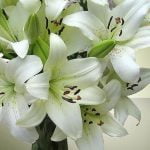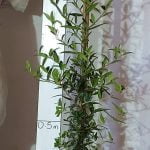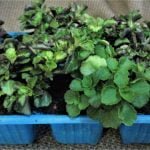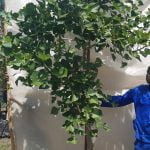Showing 685–696 of 2331 resultsSorted by popularity
- Sale!

Lilium – Asiatic Bulbs White
Original price was: R135.00.R99.99Current price is: R99.99.Add to cartLilium – Asiatic Bulbs White
Common Names: Lilium asiatic; Lilium asiflorum & Lilium longiflorum: Lily
Lilium longiflorum: St. Joseph’s lily5 Bulbs per pack
Available: May – July
Plant: May – August
Flower: September – JanuaryIt is important to plant newly bought bulbs straight after purchasing them. The soil for growing Lilium is crucial. Dig a hole of 40cm and work in compost and sand – manure is also good but must be well decomposed. After planting, add a thick mulch and water regularly. Lilium should be planted in an area that is cool but has sufficient sun in your garden – easiest to plant them under shrubs.
You can grow Lilium in pots or containers which must have a hole in the base for drainage. If you use a saucer, it should be emptied after watering. If planting in a pot, ensure that the pot has 10cm below the bulb for the roots to grow.

Olea Africana (Wild Olive) 10lt
R245.00Add to cartOlea Africana 10lt
Common Name: Wild OliveFull Sun
Low Watering
Wind Tolerant
Drought Tolerant- Sale!

Euphorbia Tirucalli Firesticks 20lt
Original price was: R480.00.R350.00Current price is: R350.00.Add to cartEuphorbia Tirucalli Firesticks 20lt

Acacia Sieberiana (Paperbark) 125lt
R3,950.00Add to cartAcacia Sieberiana 125lt
Common Name: Paperbark TreeAcacia/Vachellia sieberiana var. woodii, commonly known as the paperbark thorn, is a tree species within the Fabaceae family.
Botanical Characteristics
Leaves: The paperbark thorn has bipinnate leaves, which are typical of many Acacia species. The leaflets are small, giving the leaves a fine, feathery appearance.
Bark: As the common name suggests, the bark of this tree is papery and peels off in thin flakes. It is usually a creamy white to light brown colour.
Thorns: The tree features paired white thorns at the base of the leaves, which are straight and can be quite sharp.
Flowers: It produces small, spherical, yellow to creamy-white flower clusters that are fragrant and attract various pollinators.
Fruit: The tree bears elongated, flattened pods that contain seeds. The pods are typically a light brown colour when mature.Growing Conditions
Climate: Paperbarks thrive in warm, tropical to subtropical climates and is commonly found in savannas and open woodland areas.
Soil: It prefers well-drained soils but is adaptable to a range of soil types, including sandy and loamy soils.
Watering: This species is drought-tolerant, making it well-suited to areas with seasonal rainfall.Ecological Role
Habitat: The paperbark thorn is an important species in its native habitat, providing shelter and food for various wildlife, including insects, birds, and mammals.
Nitrogen Fixation: Like many legumes, it has a symbiotic relationship with nitrogen-fixing bacteria in its root nodules, which helps enrich the soil with nitrogen.Uses
Timber: The wood is hard and durable, used for construction, furniture, and tools.
Traditional Medicine: Various parts of the tree are used in traditional medicine to treat ailments such as coughs, colds, and skin infections.
Fodder: The leaves and pods are a source of food for livestock during dry seasons.
Gum: The tree exudes a gum that can be used similarly to gum arabic.Nutritional and Health Benefits
Herbal Remedies: Traditional uses include the treatment of respiratory and gastrointestinal issues, due to the antimicrobial properties of the plant extracts.
Anti-inflammatory: The bark and leaves have been used in poultices to reduce inflammation and promote healing of wounds.Cultivation and Management
Propagation: The tree is typically propagated from seeds, which often require pre-treatment such as soaking or scarification to enhance germination.
Growth Rate: It has a moderate to fast growth rate, particularly in favourable conditions with adequate water and nutrients.
Management: Pruning may be necessary to manage its thorny branches and to shape the tree for aesthetic or practical purposes.Conservation and Environmental Importance
Soil Conservation: Its deep root system helps prevent soil erosion, making it valuable in stabilizing soil in its native range.
Biodiversity: It supports biodiversity by providing habitat and food for a variety of organisms.Acacia/Vachellia sieberiana var. woodii is a versatile and ecologically significant tree, playing a crucial role in its natural habitat while offering numerous benefits for human use and environmental sustainability.
- Sale!

Cripps Red Apple 40lt
Original price was: R1,100.00.R799.99Current price is: R799.99.Add to cartCripps Red Apple 40lt
- Sale!

Devils Ivy 15cm Pot
Original price was: R175.00.R109.99Current price is: R109.99.Add to cartScindapsus Aureus 15cm Pot
Common Name: Devils Ivy 


Coral Tree 70lt
R2,450.00Add to cartErythrina Lysistemon Tree 70lt
Common Name: Coral Tree, Lucky Bean Tree
Gold Leyland Cypress Tree 70lt
R2,450.00Add to cartCupressocyparis Leylandii ‘Gold Rider’ 70lt
Common Name: Gold Leyland cypressApprox 2.5m Tall
- Sale!

Sansevieria Trifasciata 17cm Pot
All Indoor Plants, All Plants, Full Sun Plants, Other Indoor Plants, Semi Shade Plants, Shade Plants, Succulents, Water Wise PlantsOriginal price was: R150.00.R99.99Current price is: R99.99.Add to cartSansevieria Trifasciata 17cm Pot
- Sale!

Peperomia Amigo Marcello 14cm Pot
Original price was: R125.00.R99.99Current price is: R99.99.Add to cartPeperomia Amigo Marcello 14cm Pot
Morning Sun
Well Light Room
Can tolerate shadePeperomia make great house and office plants. Can handle most lights conditions and even non natural light!
Water when top of soil is dry and only water the soil for best results. They do not need watering too often as they are water storers.
Feed yearly or bi-yearly.












